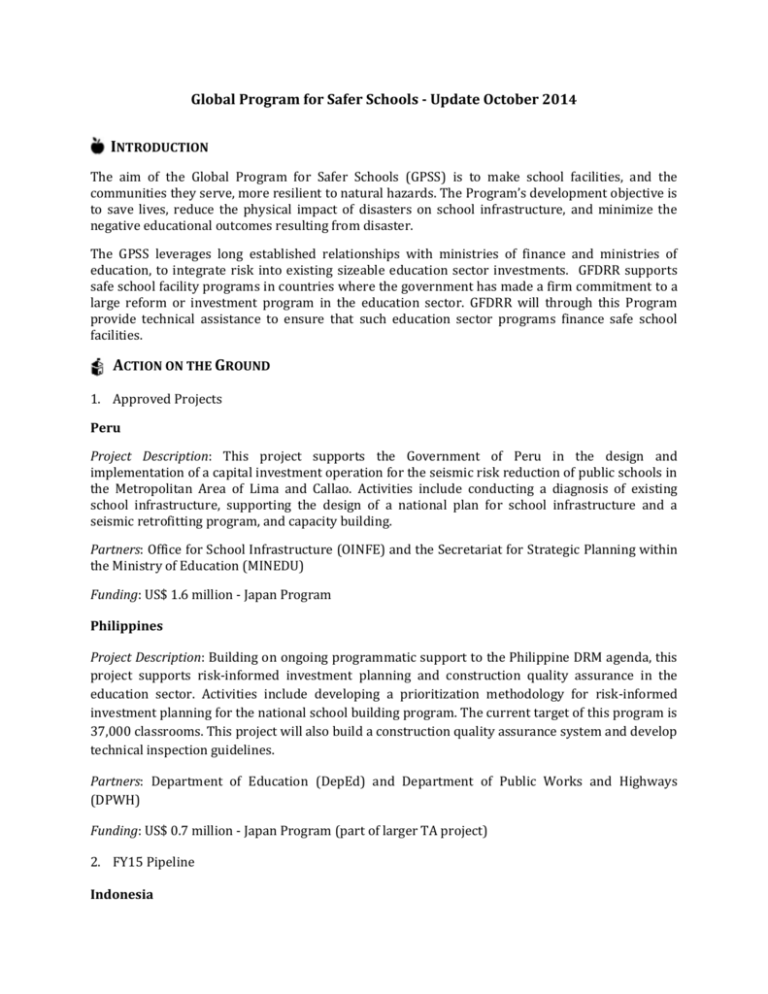Global Program for Safer Schools (GPSS)
advertisement

Global Program for Safer Schools - Update October 2014 INTRODUCTION The aim of the Global Program for Safer Schools (GPSS) is to make school facilities, and the communities they serve, more resilient to natural hazards. The Program’s development objective is to save lives, reduce the physical impact of disasters on school infrastructure, and minimize the negative educational outcomes resulting from disaster. The GPSS leverages long established relationships with ministries of finance and ministries of education, to integrate risk into existing sizeable education sector investments. GFDRR supports safe school facility programs in countries where the government has made a firm commitment to a large reform or investment program in the education sector. GFDRR will through this Program provide technical assistance to ensure that such education sector programs finance safe school facilities. ACTION ON THE GROUND 1. Approved Projects Peru Project Description: This project supports the Government of Peru in the design and implementation of a capital investment operation for the seismic risk reduction of public schools in the Metropolitan Area of Lima and Callao. Activities include conducting a diagnosis of existing school infrastructure, supporting the design of a national plan for school infrastructure and a seismic retrofitting program, and capacity building. Partners: Office for School Infrastructure (OINFE) and the Secretariat for Strategic Planning within the Ministry of Education (MINEDU) Funding: US$ 1.6 million - Japan Program Philippines Project Description: Building on ongoing programmatic support to the Philippine DRM agenda, this project supports risk-informed investment planning and construction quality assurance in the education sector. Activities include developing a prioritization methodology for risk-informed investment planning for the national school building program. The current target of this program is 37,000 classrooms. This project will also build a construction quality assurance system and develop technical inspection guidelines. Partners: Department of Education (DepEd) and Department of Public Works and Highways (DPWH) Funding: US$ 0.7 million - Japan Program (part of larger TA project) 2. FY15 Pipeline Indonesia Project Description: In the context of Indonesia’s decentralized education system, this project will focus on policy reforms related to the delivery of education infrastructure and improving local implementation practices. Activities will include inter alia developing school master plans, improving the design and construction standards, and developing ICT tools to improve monitoring and supervision activities. Partners: Ministry of Education, Ministry of Religious Affairs, National Agency for Disaster Management (BNPB), Arup, UNESCO, and Build Change Funding: US$ 0.7 million – MDTF Mozambique Project Description: This project will support enhancing the policy and regulatory environment to increase the resilience of schools and provide technical assistance to optimize the delivery of resilient schools at local level – targeting both government and community construction. Partners: Ministry of Education (MINED), Ministry of Public Works and Housing (MOPH), and National Institute for Disaster Management (INGC), and UN-Habitat Funding: US$ 1.15 million - MDTF Other projects that may to be added to the pipeline include: Armenia, Bangladesh, Nepal, and the Pacific. To date, financing for the Pacific has been confirmed (MDTF – Australia). PARTNERSHIPS AND COORDINATION Global Alliance The Global Alliance brings together various key development partners working on school safety, including UNISDR, UNICEF, UNESCO, INEE, World Vision, Plan International, and Save the Children. Partnership Description: The GPSS supports UNISDR’s Worldwide Initiative for Safe Schools to be launched in March 2015 in Sendai. Together with UNESCO, this support focuses on implementing activities aligned with the first pillar of the WISS (safer school facilities). The other Alliance partners focus on the implementation of the second (school disaster management) and the third pillar (risk reduction and resilience education). Save the Children Save the Children Australia is one of the 30 member organizations that form part of the Save the Children Association. The GPSS works with the team responsible for promoting a child-centred approach in DRR and climate change activities. Partnership Description: Save the Children is working with the GPSS on advancing the global community of practice on Comprehensive School Safety and building the evidence base for community-based safe school construction. Arup, UNESCO, and other NGOs have agreed to collaborate on developing community-based construction case studies. A draft report will be ready by March 2015 Arup Arup is an independent firm of designers, planners, engineers, consultants and technical specialists. The GPSS works with a team within Arup that works exclusively with humanitarian and development organizations committed to reduce poverty and vulnerability and increase resilience. Partnership Description: Arup is providing technical support to various World Bank teams during the preparation and implementation of GFDRR financed activities in the education sector. This support will focus on engineering, capacity assessments of contractors and builders, procurement and contract management, quality assurance environment, and other aspects of school infrastructure delivery. Support has been confirmed for Mongolia and Indonesia during FY15 Q1. Additional support is being discussed for Peru and the Pacific. Furthermore, Arup is working with the GPSS on developing a guidance note for the preparation of safer school technical assistance (TA) projects. This note will allow development practitioners to diagnose relations and capacities of the institutional landscape for school construction, define the required skills and capabilities of the project team during the TA preparation phase, and define required time of each diagnosis and design tasks for the TA preparation. A first draft will be ready by the end of FY15. MEASURING PROGRESS In FY15, the GPSS will be primarily focused on building a global baseline of schools. By the end of November, there will be a report which outlines 3-5 options for data collection. Subsequently, the GPSS will allocate resources to start the collection of the required data.











